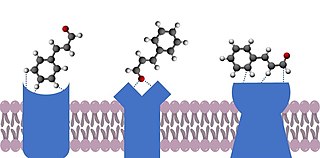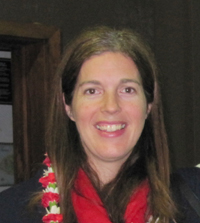
The vomeronasal organ (VNO), or Jacobson's organ, is the paired auxiliary olfactory (smell) sense organ located in the soft tissue of the nasal septum, in the nasal cavity just above the roof of the mouth in various tetrapods. The name is derived from the fact that it lies adjacent to the unpaired vomer bone in the nasal septum. It is present and functional in all snakes and lizards, and in many mammals, including cats, dogs, cattle, pigs, and some primates. Some humans may have physical remnants of a VNO, but it is vestigial and non-functional.

The olfactory bulb is a neural structure of the vertebrate forebrain involved in olfaction, the sense of smell. It sends olfactory information to be further processed in the amygdala, the orbitofrontal cortex (OFC) and the hippocampus where it plays a role in emotion, memory and learning. The bulb is divided into two distinct structures: the main olfactory bulb and the accessory olfactory bulb. The main olfactory bulb connects to the amygdala via the piriform cortex of the primary olfactory cortex and directly projects from the main olfactory bulb to specific amygdala areas. The accessory olfactory bulb resides on the dorsal-posterior region of the main olfactory bulb and forms a parallel pathway. Destruction of the olfactory bulb results in ipsilateral anosmia, while irritative lesions of the uncus can result in olfactory and gustatory hallucinations.

Interneurons are neurons that connect to brain regions, i.e. not direct motor neurons or sensory neurons. Interneurons are the central nodes of neural circuits, enabling communication between sensory or motor neurons and the central nervous system (CNS). They play vital roles in reflexes, neuronal oscillations, and neurogenesis in the adult mammalian brain.

The docking theory of olfaction proposes that the smell of an odorant molecule is due to a range of weak non-covalent interactions between the odorant [a ligand] and one or more G protein-coupled odorant receptors. These include intermolecular forces, such as dipole-dipole and Van der Waals interactions, as well as hydrogen bonding. More specific proposed interactions include metal-ion, ion-ion, cation-pi and pi-stacking. Interactions can be influenced by the hydrophobic effect. Conformational changes can also have a significant impact on interactions with receptors, as ligands have been shown to interact with ligands without being in their conformation of lowest energy.
The antennal lobe is the primary olfactory brain area in insects. The antennal lobe is a sphere-shaped deutocerebral neuropil in the brain that receives input from the olfactory sensory neurons in the antennae and mouthparts. Functionally, it shares some similarities with the olfactory bulb in vertebrates. The anatomy and physiology function of the insect brain can be studied by dissecting open the insect brain and imaging or carrying out in vivo electrophysiological recordings from it.
Luca Turin is a biophysicist and writer with a long-standing interest in bioelectronics, the sense of smell, perfumery, and the fragrance industry.

Catherine Dulac is a French–American biologist. She is the Higgins Professor in Molecular and Cellular Biology at Harvard University, where she served as department chair from 2007 to 2013. She is also an investigator at the Howard Hughes Medical Institute. She was born in 1963 in France. She came to the United States for her postdoctoral study in 1991.
Optogenetics is a biological technique to control the activity of neurons or other cell types with light. This is achieved by expression of light-sensitive ion channels, pumps or enzymes specifically in the target cells. On the level of individual cells, light-activated enzymes and transcription factors allow precise control of biochemical signaling pathways. In systems neuroscience, the ability to control the activity of a genetically defined set of neurons has been used to understand their contribution to decision making, learning, fear memory, mating, addiction, feeding, and locomotion. In a first medical application of optogenetic technology, vision was partially restored in a blind patient with Retinitis pigmentosa.

Cornelia Isabella "Cori" Bargmann is an American neurobiologist. She is known for her work on the genetic and neural circuit mechanisms of behavior using C. elegans, particularly the mechanisms of olfaction in the worm. She has been elected to the National Academy of Sciences and had been a Howard Hughes Medical Institute investigator at UCSF and then Rockefeller University from 1995 to 2016. She was the Head of Science at the Chan Zuckerberg Initiative from 2016 to 2022. In 2012 she was awarded the $1 million Kavli Prize, and in 2013 the $3 million Breakthrough Prize in Life Sciences.

Alexander "Axel" Borst is a German neurobiologist. He is director at the Max Planck Institute for Biological Intelligence and head of the department Circuits – Computation – Models.

The sense of smell, or olfaction, is the special sense through which smells are perceived. The sense of smell has many functions, including detecting desirable foods, hazards, and pheromones, and plays a role in taste.

Leslie Birgit Vosshall is an American neurobiologist and currently a Howard Hughes Medical Institute (HHMI) investigator and the Robin Chemers Neustein Professor of Neurogenetics and Behavior at The Rockefeller University. In 2022 she was appointed Chief Scientific Officer and vice president of HHMI. She is also the director of the Kavli Neural Systems Institute at The Rockefeller University. Vosshall, a member of the National Academy of Sciences, is known for her contributions to the field of olfaction, particularly for the discovery and subsequent characterization of the insect olfactory receptor family, and the genetic basis of chemosensory behavior in mosquitoes. She has also extended her research into the study of human olfaction, revealing parts of human genetic olfactory architecture, and finding variations in odorant receptors that determine individuals’ abilities to detect odors.
The lateral horn is one of the two areas of the insect brain where projection neurons of the antennal lobe send their axons. The other area is the mushroom body. Several morphological classes of neurons in the lateral horn receive olfactory information through the projection neurons.
A Drosophila connectome is a list of neurons in the Drosophila melanogaster nervous system, and the chemical synapses between them. The fly's nervous system consists of the brain plus the ventral nerve cord, and both are known to differ considerably between male and female. Dense connectomes have been completed for the female adult brain, the male nerve cord, and the female larval stage. The available connectomes show only chemical synapses - other forms of inter-neuron communication such as gap junctions or neuromodulators are not represented. Drosophila is the most complex creature with a connectome, which had only been previously obtained for three other simpler organisms, first C. elegans. The connectomes have been obtained by the methods of neural circuit reconstruction, which over the course of many years worked up through various subsets of the fly brain to the almost full connectomes that exist today.
Gaiti Hasan is an Indian scientist who researches in the fields of molecular biology, genetics, neuroscience and cell signalling. Hasan is a Fellow of the Indian National Science Academy (INSA), the apex body of Indian scientists and technologists. From 2013 onwards she has been serving as a Senior Professor at the National Centre for Biological Sciences (NCBS), Bangalore.

Insect olfaction refers to the function of chemical receptors that enable insects to detect and identify volatile compounds for foraging, predator avoidance, finding mating partners and locating oviposition habitats. Thus, it is the most important sensation for insects. Most important insect behaviors must be timed perfectly which is dependent on what they smell and when they smell it. For example, olfaction is essential for locating host plants and hunting prey in many species of insects, such as the moth Deilephila elpenor and the wasp Polybia sericea, respectively.
Gregory Stephen Xavier Edward Jefferis is a British neuroscientist known for his work on the circuit basis of olfactory perception in the vinegar fly, Drosophila melanogaster. He is a tenured Programme Leader at the MRC Laboratory of Molecular Biology in Cambridge (UK) and associated with the Department of Zoology at the University of Cambridge.
Nilay Yapici is a Turkish neuroscientist at Cornell University in Ithaca, New York, where she is the Nancy and Peter Meinig Family Investigator in the Life Sciences and Adelson Sesquicentennial Fellow in the Department of Neurobiology and Behavior. Yapici studies the neural circuits underlying decision making and feeding behavior in fruit fly models.

Hu Hailan is a Chinese neuroscientist, professor, and executive director of the Center for Neuroscience at Zhejiang University School of Medicine in Hangzhou, China. Hu explores neural mechanisms underlying social behaviors and psychiatric diseases. She specifically explores the neural substrates of social rank and the role of neuron-glia interactions in driving depressive behaviors. Hu discovered the anatomical and molecular targets of ketamine's fast-acting antidepressant effects to be localized to the lateral habenular circuits in rodents. Hu was also the first scientist outside of Europe and America to be awarded the IBRO-Kemali Prize in over 20 years. She is also a member of the Jiusan Society.

Pavan Ramdya is an American and Swiss neuroscientist and bioengineer. His research centers on understanding the cognitive and neuromechanical control of behavior toward applications in robotics and artificial intelligence. He holds the Firmenich Next Generation Chair in neuroscience and bioengineering at EPFL, and is head of the Neuroengineering Laboratory at EPFL's School of Life Sciences.












